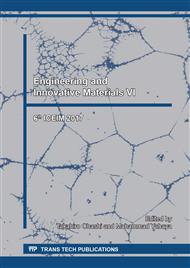p.186
p.191
p.196
p.201
p.208
p.213
p.218
p.225
p.230
Eccentricity Effect in the Hole-Drilling Residual Stress Measurement
Abstract:
The paper focuses on the analysis of the eccentricity effect in the measurement of the hole-drilling residual stress. Relaxed strains were evaluated by computational simulation of the hole-drilling experiment using the finite element method. Errors induced by eccentricity were estimated for elastic and elastic-plastic states in area around the drilled hole due to the stress concentration. The invariance of the stress change with depth was assumed. The correction of eccentricity and plasticity effects in evaluation of residual stresses was realized within the EVAL 7 software (SINT Technology). The analysis shows that in elastic state the eccentricity and angular position of the drilled hole have a significant effect on relative residual stress errors. Correction according to the HDM method is very effective in this case. If the relative error of 5 % is allowed, which is in engineering practice acceptable, eccentricity of ±0.05 mm could be accepted without correction. When the combination of eccentricity and plasticity occurs, the correction of plasticity is more important in method 13-EXT-UN.
Info:
Periodical:
Pages:
208-212
Citation:
Online since:
January 2018
Authors:
Keywords:
Price:
Сopyright:
© 2018 Trans Tech Publications Ltd. All Rights Reserved
Share:
Citation:


